Watershot WDS-450D underwater housing for Canon Rebel XSi/450D
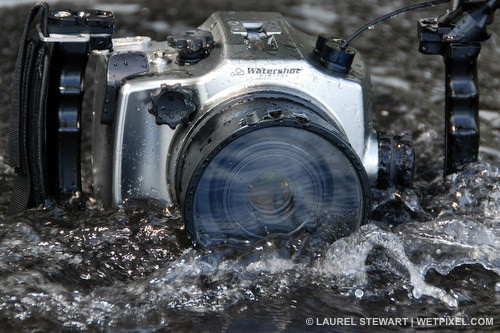
I have to confess to never having taken anything more than a drugstore-purchased disposable camera underwater, so I was thrilled to have the chance to take the Watershot WDS-450D underwater housing for the Canon Digital Rebel XSi / 450D on a Wetpixel trip to Indonesia this spring. I spent 7 days in Lembeh Strait, and an additional 3 days in the Bunaken area.
I was the only person who showed up in the camera room on the first day with my gear still in original boxes, but the experienced members of the Wetpixel group were very helpful in getting me set up and showing me the basics of underwater photography with an SLR. The Watershot housing was well packaged, and the instructions, easy to follow. The camera body is screwed onto a metal mounting plate and pushed into rails in the housing. There is a satisfying click as the camera is set properly.
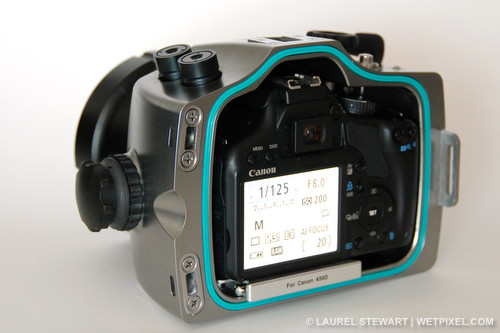
Back left view of the Watershot WDS-450D housing with
Canon Digital Rebel XSi / 450D mounted inside
The housing uses a gasket type seal as opposed to a regular O-ring for the main body (because it has two sealing surfaces rather than one), but it was simple to set up by following the manual. The latching system also had a solid feel to it. The fiber optic strobe cable connection was easy to use and worked perfectly.
During my time in Indonesia, I used a Canon 60mm EF-S macro lens, a standard Watershot flat port, and a single Inon Z-240 type 2 strobe, all graciously supplied by Steve Philbrook at Watershot. While the Canon 18-55mm kit lens works with the flat port, a dome port would probably result in better photos.
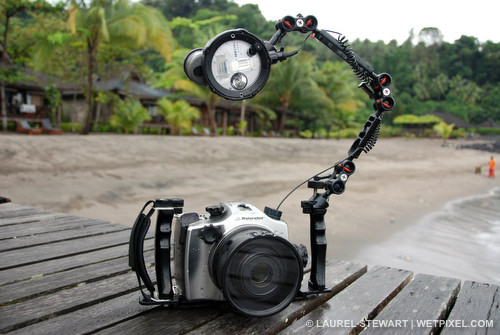
Watershot WDS-450D underwater housing for Canon Digital Rebel XSi (450D)
with INON strobe arms, clamps, Z-240 strobe and fiber sync kit.
While it took me some time to become comfortable in the water with a camera, I had no trouble with the housing nor the camera. The handles were comfortable, and the levers, knobs, and buttons were all easy to reach. I spent the first couple dives with the camera set to basic settings recommended by the Wetpixel folk, and experimented more and more as I continued to dive.
The housing has both a visual and audio warning that activates when water gets into the housing. Happily, I can report that I did not see or hear either throughout the trip.
CONCLUSION:
Overall, a great experience with a sleek and well-designed solid product!
TECH TALK:
Watershot currently supports the Athena 6” glass dome (with a Watershot flange). They are currently designing a small, economic, acrylic dome for XSi users, and are also planning to release an 8” glass dome. 16mm and a 60mm port extenders are available.
Current gear support for lenses are as follows:
- Tokina 10-17mm fisheye
- Canon 10-22mm wide angle
- Canon 18-55mm kit lens
- Canon 60mm macro
Watershot says that they are also looking at support for the Sigma 10-20mm and Sigma 17-70mm DC macro.
The WDS-450D Housing Kits are now available at a retail price of $1995 USD, including the following items:
- Machined aluminum housing
- Standard flat port
- 18-55mm zoom gear
- Hand strap
- Leak sensor
- 2x optical bulkheads for fiber sync
For more information about the Watershot WDS-450D, see:
http://www.watershothousings.com/index_files/Page2643.htm
Watershot is also working on a housing for the Canon 5D Mark II.
NOTES FROM ERIC CHENG:
Although there are housings for SLRs that weigh in at nearly half the cost, the Watershot housing feels like a high-end product. It’s beautiful, and it’s machined out of a solid chunk of aluminum. Everything about it feels good. Because the housing is for a Digital Rebel series camera, there is only one exposure dial, which means that no housing for this camera can support one dial for shutter speed and another for aperture; a button press is necessary to toggle between the two.
I was happy to see that the * button is easily reachable from shooting position, so it is possible to use the * button for focus instead of a half press of the shutter lever.
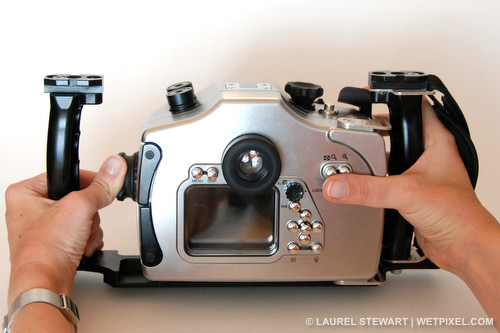
The * button can be reached while depressing the shutter button.
The mounting plate, which is attached to the camera to allow it to slide into the rails at the bottom of the housing, is light and strong. There is absolutely no wiggling of the camera once it locks into place (as Laurel says, with a satisfying click).
Strobe sync is accomplished via two fiber-optic bulkheads. Because it’s a Canon, the built-in flash on the camera will still fire even if it’s only popped open a millimeter or two. This is how the Watershot WDS-450D is designed to operate, and it has the nice side-effect of allowing for a truly compact design that supports optical sync without some sort of hotshoe-to-optical bridge. The inside of the housing itself functions as a reflector. It’s bare aluminum, and the flash bounces around inside and up into the bulkhead via simple tabs that sit below the inside opening of each bulkhead.
Laurel mentions above that the Watershot housing uses a gasket for sealing between the two housing parts instead of an o-ring. Although the gasket must sit in the groove a certain way (no arbitrary rotation), it seals with two surfaces when installed properly instead of only one (as an o-ring would seal). Although this is a little better than having only one sealing surface, one should note that a even single hair across the gasket will still result in a flood the same way it would in an o-ring-sealed housing.
Our test housing was equipped with INON arms and clamps, and a Z-240 strobe. When I took the housing out for a test dive, I set the strobe on S-TTL, put the camera in manual exposure at 1/200 sec between f8-13 or so, and fired away. Underwater, I had only used a TTL flash system once before, and like last time, I was astounded by how easy it was to expose properly! Of course, subtle lighting was impossible, but shot after shot exposed perfectly, and I soon forgot about exposure and was able to concentrate on things like… enjoying my dive. Imagine that!
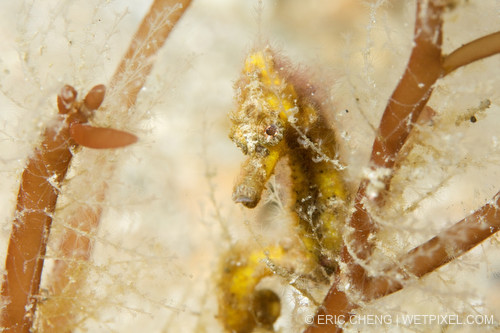
A seahorse—TTL is so easy (Lembeh Strait)
The viewfinder was adequate for basic framing, but one should not imagine that it is possible to tell critical focus when using such a small viewfinder. Luckily, autofocus worked well enough, and most of my shots were sharp. I am not sure whether the Watershot housing supports a larger viewfinder, but it is something that Watershot must be thinking about if they are to be competitive in the higher-end underwater housing market (I refer to the 5D Mk II housing they are working on).
The entire rig was negative in the water, but was much easier to handle than my normal SLR rig, which is enormous, highly-negative, and bulky. It surprises me every time I pick up a housing that is even a little bit smaller than mine is; with every millimeter shaved off, a still housing becomes easier to use—to a certain point, of course. When a housing becomes too small, it also becomes difficult to use. In any case, this housing was so small and easy to use that I felt like I was cheating!
Watershot’s staff comes from the old INON America group, who in the past have been able to service products efficiently—and with a smile, too. Hopefully, Watershot will be successful enough for them to keep prices competitive and products readily available. I’m excited to see Watershot’s entry into the SLR housing market.